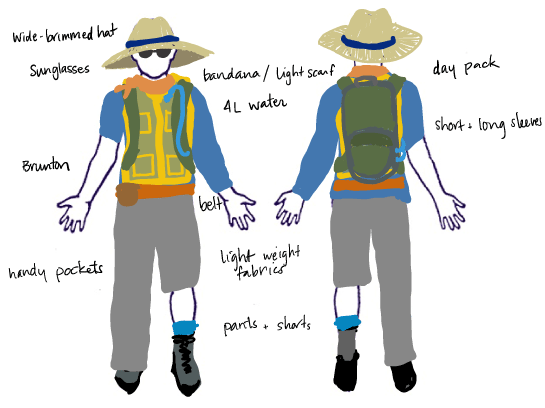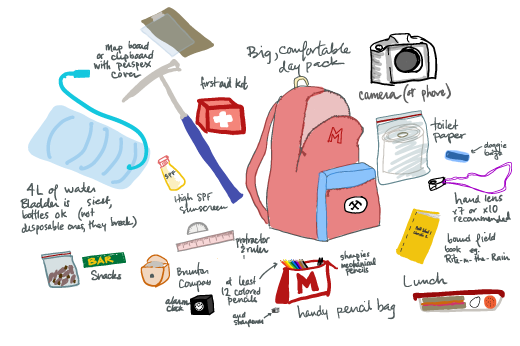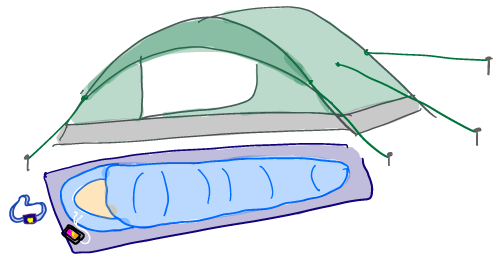Geologic History
The core of North America consists of old (Archean-Proterozoic) metamorphosed
rock including supracrustals (sediments and volcanics) and orthogneisses
(intrusive igneous rocks). These rocks are often referred to as 'basement'
because they are unconformably overlain in most areas by younger rock. They
are diverse but mostly covered, only exposed where blocks of crust have been
tectonically uplifted so that the cover eroded away. Much argument is devoted
to matching these rocks to other continents to understand the linkages across
earlier supercontinental cycles.
From the late Proterozoic until near the end of the Paleozoic, the western
margin of North America was a wide shallow continental shelf with little
or no tectonic activity (passive margin). Steady sedimentation (clastic and
carbonate) built up a thick sequence of sediments containing fossils which
record the Cambrian Explosion!
Tectonic activity began in the late Paleozoic and a series of collisions
brought new terranes to the North American margin and resulted in shortening
of the platform sediments. Subduction initiated in the middle Mesozoic.
Western North America rose above sea level and sedimentation changed from
marine to subaerial. Arc-related and plate-reorganization-related magmatic
activity produced the 148 Ma Independence Dike Swarm and lots of small plutons
which contributed to ore deposit formation in the eastern Sierra. The
Keystone-Muddy Mountain Thrust system developed during the late Cretaceous
Sevier Orogeny and shallowly thrust older marine rocks inland (eastward) over
the Mesozoic continental sediments. Steeper reverse faults took over from
low angle thrusts in some areas, indicating a change in orogenic style called
the Laramide Orogeny. Laramide uplifts revealed Proterozoic crystalline rocks
in some of the mountain ranges. The early part of the Cenozoic was not
well recorded in the rocks of the region.
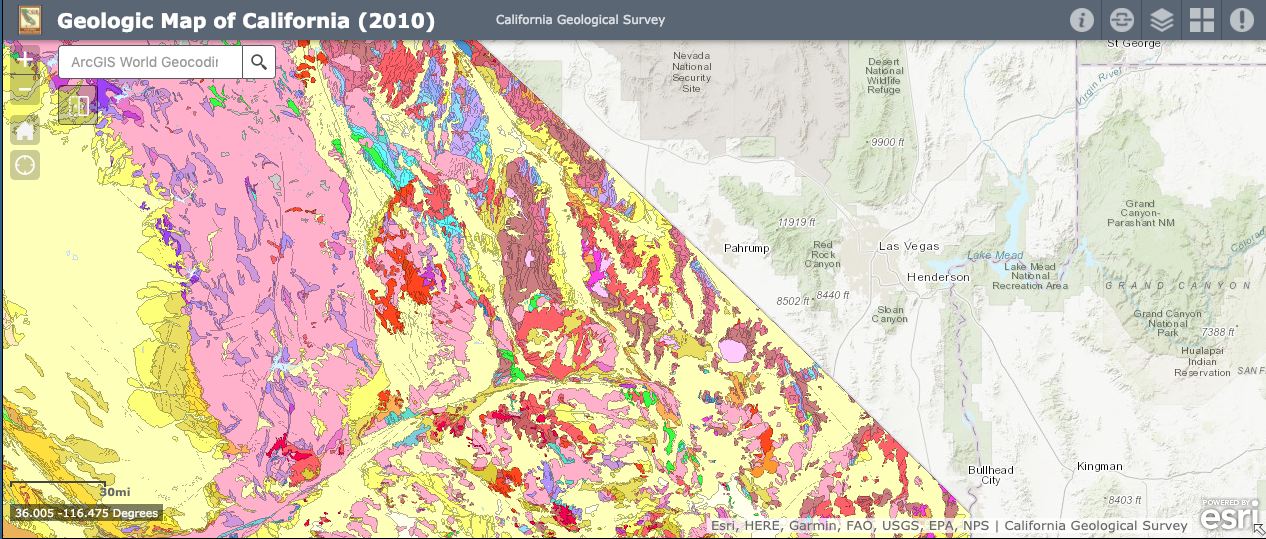
Geologic map of southern California, grabbed from the California Geological
Survey. Light yellow = recent sediments. Red = recent
volcanics. Pink = Mesozoic granites. Bright green and light blues =
metamorphic basement.
During the Miocene, extension started up and produced both steep normal
faults and shallowly dipping detachments. The geometry of these fault systems
usually result in older faults rotating out of favorable orientation and new
faults developing, so the current landscape includes many active and dormant
normal faults. Uplifting continental blocks become mountain ranges and shed
sediments into the basins between them, giving the region of extension the
characteristic "Basin and Range" landforms. During recent colder and wetter
times (Plio-Pleistocene), many of these valleys were filled with lakes and
big glaciers in the High Sierras fed major outflowing rivers whose sediments
still blanket the landscape. At the present time, the right-
lateral strike-slip motion of the Pacific-North America plate boundary, which
is mostly taken up on the San Andreas Fault system near the coast, has
partitioned some of the motion inland producing oblique and even strike slip
motion in the Eastern California Shear Zone / Walker Lane (a zone of faults
along the eastern side of the Sierra Nevada). Many of these normal and
strike slip faults are "leaky" - occasionally erupting small cones and flows.
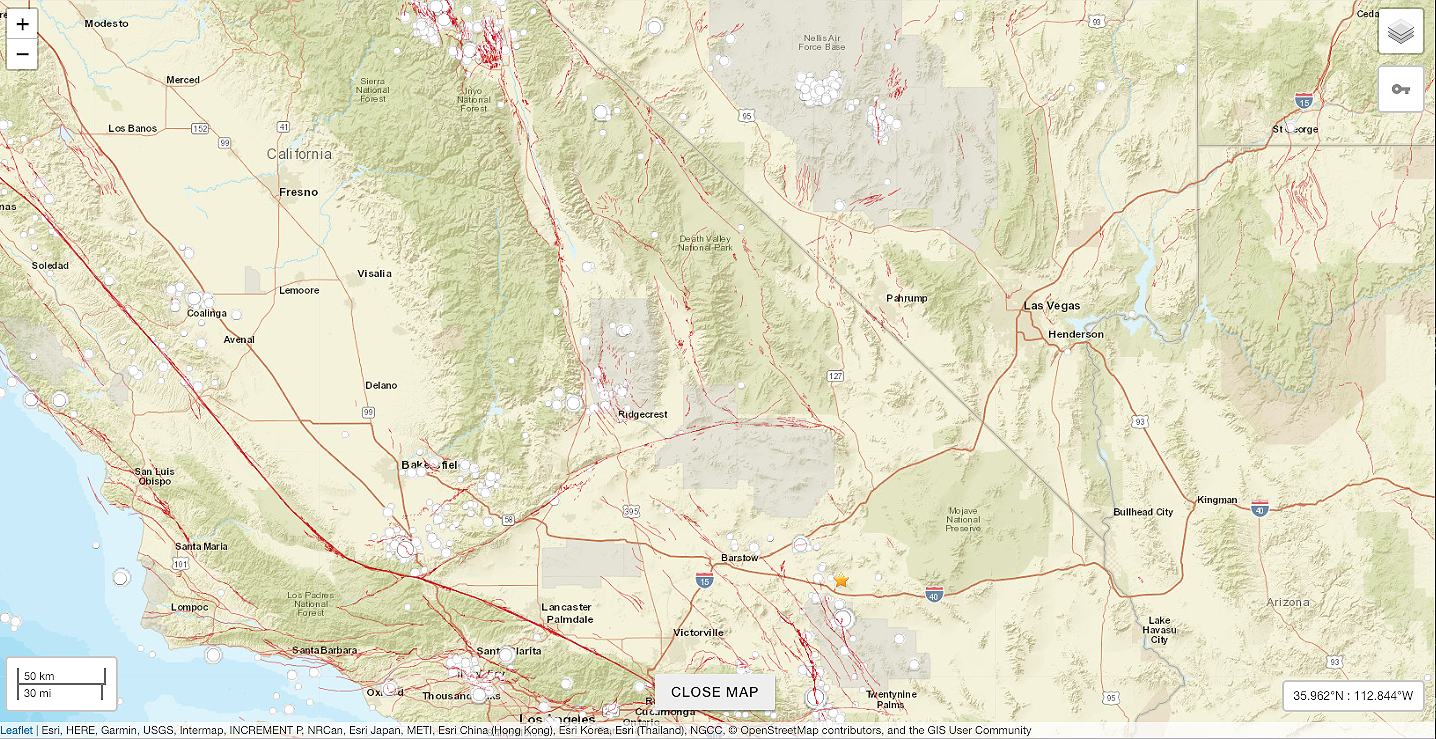
Active faults in the Mojave-Las Vegas area. White circles are earthquakes
during the last 12 months, scaled by magnitude (largest ~ 3.6). Image grabbed
from earthquake.usgs.gov
| Day |
Activity |
Where we sleep |
Groceries? |
Shower? |
| 22 Jan 17:30 |
First Informational Meeting, FDA 211 |
|
|
|
| Weds February 20, 3:00-4:30 |
Discuss: Regional Overview, assign poster topics for 645 students |
FDA 232 (small conference room near auditorium) |
|
|
| Weds March 20, 3:30-5:00 |
Discuss: Sevier/Laramide and Basin and Range |
FDA 232 |
|
|
| Weds 10 April, 1-3:30 pm |
Discuss: Extension and Strike-slip |
FDA 232 |
|
|
| April 17 OR 19 (9:00-13:00) plus April 19 (13:00-17:00_ |
Orientation and skills review day at McGill: "Boot Camp" |
Meet at FDA |
|
|
| Tues 30 April |
Christie fly to Las Vegas |
|
|
|
| Weds 1 May |
Students and TAs fly to Vegas, groceries |
Black Canyon Group Campsite, Mojave |
Groceries in LV |
|
| Thurs 2 May |
Mojave National Preserve, start notebooks |
Black Canyon Group Campsite, Mojave |
|
|
| Fri 3 May |
Shop in Barstow, Calico Folds (maybe) |
Owl Canyon Campground |
Stater Bros. |
KOA- quick showers |
| Sat 4 May |
Introduction to Rainbow Basin and Waterman Hills, start mapping |
Owl Canyon Campground |
|
|
| Sun 5 May |
Rainbow Basin and Waterman Hills mapping |
Owl Canyon Campground |
|
|
| Mon 6 May |
Rainbow Basin and Waterman Hills mapping |
Travelodge by Wyndham Barstow |
|
shower + laundry |
| Tues 7 May |
Groceries; sites in Eastern Sierra/Owens Valley |
Grays Meadow Campsite |
Von's in Barstow |
|
| Weds 8 May |
Death Valley - Titus Canyon,
Mesquite Dunes |
Mesquite Spring, DVNP |
|
|
| Thurs 9 May |
Little Hebe stratigraphy, Badwater, detachment |
SHEAR in Shoshone |
|
Yes |
| Fri 10 May |
Drive through LV, shop, set up camp at Muddy Mountain |
Buffington Windows (wild camp) |
Grocery shop |
|
| Sat 11 May |
Mapping Muddy Mountain |
Buffington Windows (wild camp)
| |
|
| Sun 12 May |
Mapping Muddy Mountain |
Buffington Windows (wild camp) |
Small shop at Moapa |
option to shower at Moapa Travel Plaza |
| Mon 13 May |
Mapping Muddy Mountain |
Buffington Windows (wild camp) |
|
|
| Tues 14 May |
Valley of Fire |
Valley of Fire group camp |
|
|
| Weds 15 May |
Valley of Fire |
Valley of Fire group camp |
|
Showers at Moapa Travel Plaza |
| Thurs 16 May |
Clean up equipment, storage, airport |
N/A |
|
|



